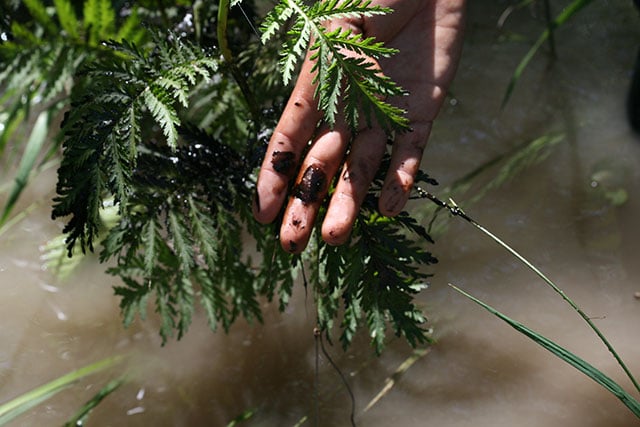
Early in the morning on July 2, 2011, I walked down the gravel road on our Montana farm to let the goats out to graze for the day. I found an oily rainbow sheen on the Yellowstone River flowing through our hay fields and pasture, plus large clumps of crude oil sticking to trees, cattails and brush. The oily water was in our sloughs, our pond and the creek that runs along the eastern edge of the farm. I checked the local news on my phone and found that an Exxon oil pipeline had ruptured underneath the Yellowstone River upstream. More than 300 people upstream from us were evacuated, but no one had thought to notify those of us further from the spill. The smell of hydrocarbons was overwhelming.
In the end, more than 63,000 gallons of crude oil spilled into the Yellowstone River from what we later learned was a “guillotine cut” in Exxon’s Silvertip pipeline, which lay in a trench only four to five feet under the Yellowstone River. Snowmelt combined with spring rains had caused heavy flooding, and the river bottom was scoured away, leaving the oil pipeline exposed. All it took was a heavy object being tossed down the river to break the pipeline in half. After spending $135 million on the cleanup, Exxon recovered less than 1 percent of the oil spilled.
It took Exxon over an hour to completely shut down the pipeline, according to the report filed by federal regulators. Federal investigators found that damage would have been reduced by about two thirds if the pipeline controllers in Houston had closed the appropriate valve as soon as a problem was detected. It took them three days to assemble a full cleanup response team.
On July 4, 2011, my mother drove me to the hospital because I was suffering from nausea, a severe headache that hadn’t gone away in two days, dizziness and painful breathing. The doctor diagnosed me with acute hydrocarbon exposure, and for one year after the spill it hurt my lungs to take a deep breath. We are on year five now of trying to rebuild our soil and restore our pastures back to their original condition.
After the spill, the state of Montana leaned on the Pipeline and Hazardous Materials Safety Administration (PHMSA), the federal agency responsible for inspection of pipelines and enforcement of pipeline regulations, to inspect 90 sites where pipelines crossed rivers in Montana. Twenty of those crossings were deemed a high risk for failure and the pipes there were either reburied deep underneath the river with directional drilling or strengthened.
And yet four years later, in January 2015, another oil pipeline burst underneath the Yellowstone. Sonar testing showed that about 110 feet of pipeline was exposed along the bottom of the river. In one area, river scour had removed almost an entire foot of dirt and rocks underneath the pipe, leaving it exposed top and bottom for 22 feet. Up to 54,000 gallons of oil spilled into the icy Yellowstone River. The residents in Glendive began smelling oil in their tap water, but no one was told to stop drinking the water until 24 hours after the spill. Volatile organic chemicals in the oil, including cancer-causing benzene, were found in Glendive’s water supply. Very little of the oil was recovered before the ice broke up and spring flows washed the oil downstream.
This pipeline, according to the inspections by PHMSA after the 2011 spill, was deemed a pipeline at low risk for failure.
Luckily, no one was killed in these two incidents in Montana, but oil and gas pipeline failures around the country have caused many deaths, as well as water pollution and billions of dollars in property damage.
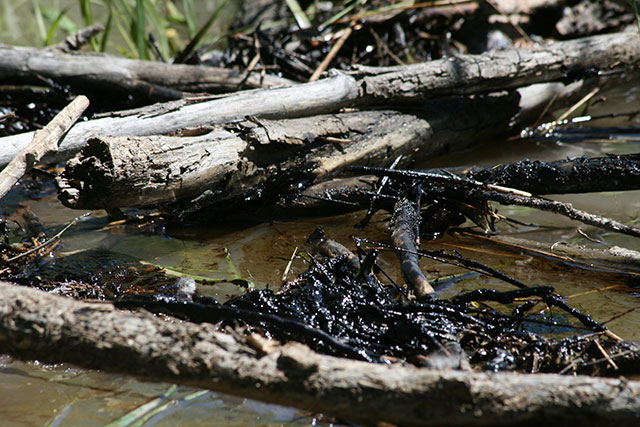 Crude oil clumps up in woody debris on the Bonogofsky farm on July 2, 2011, Exxon oil spill on the Yellowstone River. (Photo: Alexis B. Bonogofsky)
Crude oil clumps up in woody debris on the Bonogofsky farm on July 2, 2011, Exxon oil spill on the Yellowstone River. (Photo: Alexis B. Bonogofsky)
The State of Pipeline Safety in the United States
A year before the 2011 oil spill on the Yellowstone River, a 30-inch natural gas pipeline owned by Pacific Gas and Electric (PG&E) exploded in San Bruno, California, a suburb of San Francisco. The explosion and fire killed eight people and injured 58 while destroying 38 homes and damaging 70 others.
In an opening statement about the San Bruno accident report, the National Transportation Safety Board chairman summarized the board’s findings as “troubling revelations … about a company that exploited weaknesses in a lax system of oversight and government agencies that placed a blind trust in operators to the detriment of public safety.”
At the time of the San Bruno blast, just 2,000 miles away in Michigan workers were still cleaning up another pipeline break, which spilled 840,000 gallons of crude oil into the Kalamazoo River in 2010, the largest inland oil spill in the nation’s history.
The list of pipeline failures goes on and on.
The US energy pipeline network has more than 2.6 million miles of pipeline transporting natural gas, oil and other hazardous liquids, and the mileage is increasing every year. The creation of more pipelines — combined with aging pipeline infrastructure and lax oversight of pipeline companies — has led to an increase in pipeline failures.
Oil spills from pipelines are also on the rise. Since 2009, the annual number of significant accidents on oil and petroleum pipelines in the United States rose by almost 60 percent, according to an analysis of federal data by the Associated Press. The increasing number of accidents parallels an increase in oil production in the US. The analysis also found that nearly two-thirds of the leaks during that time have been linked to corrosion or failures of material, welding or equipment.
From 2005 to mid-year 2016, the total cost of significant pipeline failure incidents was over $10 billion. These incidents took the lives of 153 people and caused more than 647 injuries. PHMSA defines a significant incident as an event that includes any of the following conditions: fatality or injury requiring in-patient hospitalization, $50,000 or more in total costs measured in 1984 dollars, highly volatile liquid releases of 5 barrels of more or liquid releases of 50 barrels or more or a liquid release resulting in a fire or explosion.
To oversee these 2.6 million miles of pipeline, PHMSA only has 139 federal inspection and enforcement staff members, with the help of 300 state inspectors. They regulate nearly 3,000 companies, 118 liquefied natural gas plants and 6,970 hazardous liquid breakout tanks.
The five years between 2010 and 2015 found the public experiencing serious pipeline failures throughout the nation including the high-profile oil spills and natural gas explosions in Montana, Michigan, Arkansas, California and elsewhere.
On January 3, 2012, President Obama signed the Pipeline Safety, Regulatory Certainty, and Job Creation Act of 2011. The act contained a range of provisions addressing pipeline safety, including increasing the number of federal pipeline safety inspectors, requiring automatic shutoff valves for transmission pipelines, mandating verification of maximum allowable operating pressure for gas transmission pipelines, and increasing civil penalties for pipeline safety violations. Five years and many pipeline failures later, almost half of the mandates remain incomplete beyond the deadlines specified in the act, including several mandates that have the potential to have large impacts on pipeline safety nationwide.
For example, a provision that would require automatic shutoff valves for transmission pipelines, which would help to quickly stop the uncontrolled flow of crude oil or natural gas in the event of a pipeline failure, has not been implemented. The delay in shutting down pipelines has made many spills worse. In San Bruno, it took PG&E over 90 minutes to stop the flow of natural gas from the pipeline using manual valves. In Montana’s 2011 oil spill, it took Exxon over an hour to shut down the pipeline that was gushing oil into the Yellowstone River.
Despite the 2012 bill’s 42 mandates for PHMSA, pipeline failures have continued increasing in the years since.
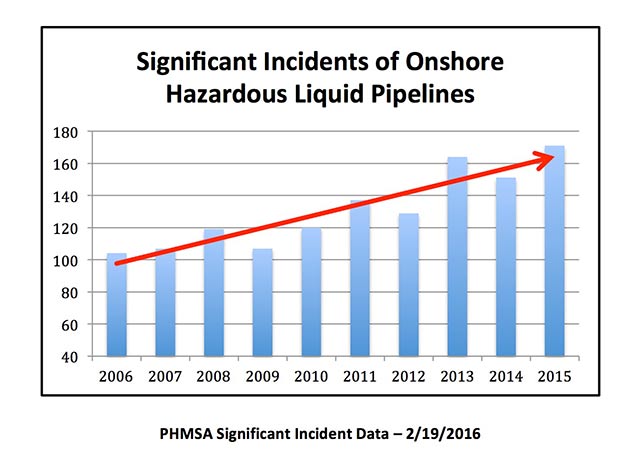 (Credit: Pipeline Safety Trust)
(Credit: Pipeline Safety Trust)
The Limits of Federal Regulations
Referencing the major failures between 2010 and 2015, Carl Weimer, executive director of the Pipeline Safety Trust — an industry and government watchdog organization that I joined the board of after my own experience with the Yellowstone River oil spill — testified in front of the House Energy and Commerce Committee concerning the reauthorization of the Department of Transportation’s Pipeline Safety Program: “Against that backdrop of incidents and congressional directives, [National Transportation Safety Board] and [Government Accountability Office] recommendations, those five years also provided a perfect example of a broken regulatory process that left PHMSA incapable of producing a single major new safety rule.”
In early June 2016, President Obama signed the PIPES Act, which added additional regulations into pipeline law and reauthorized PHMSA. This act strengthens some regulations and increases scrutiny on pipeline operators. For example, it includes a new regulation that allows PHMSA to issue an emergency order to all pipeline companies when it observes a problem with a particular pipeline that could be dangerous for other pipelines in similar situations. In the past, regulators could issue an order only to a particular violator. The bill also requires companies to have a plan in place for an oil spill that happens under ice, similar to the oil spill in Glendive, Montana.
In addition, the PIPES Act specifies that the Government Accountability Office (GAO) is required to report on the way companies manage hazardous liquid pipelines in “high consequence areas.” PHMSA defines high consequence areas as having one of three characteristics: being a populated area, serving as the source for drinking water or being an unusually sensitive ecological area. The PIPES Act also requires the GAO to study how operators manage pipelines that cross water and the impact of pipeline age on failures. The bill also requires better monitoring by companies during flood events.
When Rebecca Craven, program director for the Pipeline Safety Trust, was asked by the Billings Gazette about the impact of the new regulations, she called them “incremental improvements,” but said that companies’ spills and lack of preparedness during the spills and gas explosions isn’t necessarily from the lack of federal regulations. Companies were already required under federal law to assess risks, prepare plans for adverse conditions to their pipelines and undertake measures to minimize those risks.
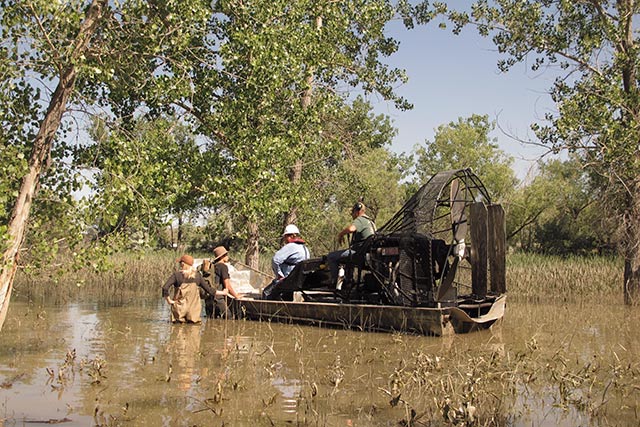 An air boat on the Bonogofsky farm was part of cleanup efforts after the 2011 Exxon oil spill on the Yellowstone River. (Photo: Avi Lewis)
An air boat on the Bonogofsky farm was part of cleanup efforts after the 2011 Exxon oil spill on the Yellowstone River. (Photo: Avi Lewis)
One of the biggest gaps in pipeline safety that the Pipeline Safety Trust has identified, yet still hasn’t been addressed in any federal regulation, concerns the effects of oil spills and gas releases on human health.
On June 12, 2010, a Chevron oil pipeline spilled oil into the Red Butte Creek drainage in Salt Lake City for the second time in a year, spilling 50-60 gallons of crude oil into the creek each minute. An order from PHMSA noted that Chevron did not respond to the pipeline break for more than 10 hours. An estimated 33,600 gallons of crude had been spilled, exposing 190 residences and numerous businesses to the fumes. One of those residences belonged to Peter Hayes, who lived along the creek. According to those who knew him, Hayes was extremely concerned about the oil spill’s effects on the people who lived along Red Butte Creek. He advocated for the creation of improved emergency response plans and for a study to determine the long-term health impacts of being exposed to crude oil. His recommendations were never put into practice.
A little more than five years later, on September 15, 2015, Hayes died from idiopathic pulmonary fibrosis, a rare lung disease that suffocates a person by destroying the tissues that distribute oxygen into the bloodstream. Some believe Hayes’ disease may have been caused by exposure to the volatile organic compounds released by the oil spill. He was 60 years old.
After most oil pipeline spills and natural gas explosions, people have reported adverse health effects from the spills, and yet no studies have been done on the long-term health impacts of these incidents.
On October 23, 2015, a massive natural gas leak was discovered by Southern California Gas Company employees in Aliso Canyon in California. Gas was being released from the underground natural gas storage facility, the second largest facility of its kind in the United States. The gas spewed into the atmosphere for more than 100 days. People who lived nearby the facility reported “headaches, nosebleeds, nausea and other symptoms to county officials.”
“We’re dealing with a gap in the science,” said Michael Jerrett, professor and chairman of the Department of Environmental Health Sciences at the University of California, Los Angeles, while speaking to InsideClimate News about the Aliso Canyon failure. “We just don’t have a very good scientific understanding of what that means for long-term health effects.”
As Weimer from the Pipeline Safety Trust told Congress this year just before the reauthorization, “We ask that as part of this reauthorization you direct PHMSA to undertake another study with the National Academy of Sciences to better understand the potential long-term health effects from pipeline failures, and provide recommendations for threshold levels that should inform evacuation decisions and necessary equipment to measure such thresholds as part of spill response plans.”
However, Congress didn’t include any directive to study health impacts from pipeline failures in its legislation.
In the last five years, Congress has passed two bills tightening pipeline regulations and giving more authority to PHMSA to enforce those regulations. After the passage of the 2012 bill, pipeline failures continued increasing, making many skeptical that the 2016 legislation will be effective in stopping pipeline failures.
Carl Weimer from the Pipeline Safety Trust summarized what he saw in the new pipeline regulation bill:
The reality of the bill is somewhat different than the much ballyhooed claims. While there is not a single provision in the pipeline safety reauthorization bill that by itself creates substantial progress to increase the safety of the pipelines in this country, the bill does have many incremental provisions that taken as a whole move pipeline safety forward. There are a few good provisions, others that provide needed clarity, and some that just encourage efforts already under way at PHMSA. With the current Congress our expectations were low, so we were quite happy that Congress worked together in a bipartisan way to exceed our expectations.
As I walk through my farm and see the weeds, the dead soil and oil lines left on the old cottonwood trees, I think about the large part of my life that I’ve spent dealing with an oil spill that I wouldn’t have had to deal with if the Exxon Pipeline Company had been forced to follow the regulations already in place. I think about my lungs and I wonder what damage was done that I might experience when I’m older. I think about Peter Hayes.
I know that most pipelines underneath the Yellowstone River are still at risk from scour and that none of the new regulations will fix that problem, since current regulations only require pipelines under rivers wider than 100 feet to be buried between 4 and 6 feet. Because of this, I know that I will most likely experience another pipeline failure on the Yellowstone in my lifetime.
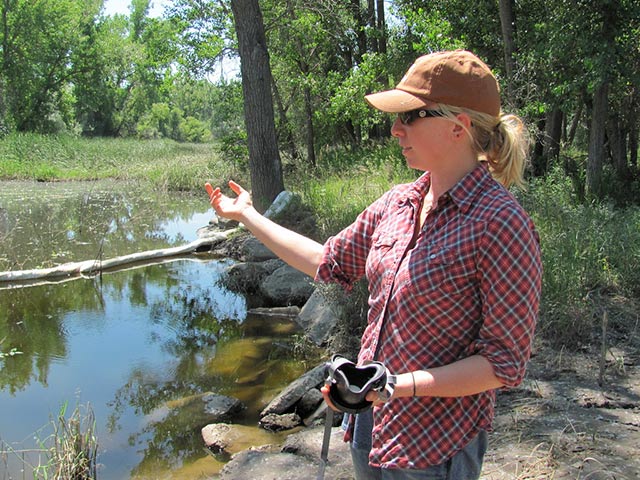 Alexis Bonogofsky shows where the oil is on the the Bonogofsky farm during the 2011 Exxon oil spill on the Yellowstone River. (Photo: Kate Sheppard)
Alexis Bonogofsky shows where the oil is on the the Bonogofsky farm during the 2011 Exxon oil spill on the Yellowstone River. (Photo: Kate Sheppard)
Our most important fundraising appeal of the year
December is the most critical time of year for Truthout, because our nonprofit news is funded almost entirely by individual donations from readers like you. So before you navigate away, we ask that you take just a second to support Truthout with a tax-deductible donation.
This year is a little different. We are up against a far-reaching, wide-scale attack on press freedom coming from the Trump administration. 2025 was a year of frightening censorship, news industry corporate consolidation, and worsening financial conditions for progressive nonprofits across the board.
We can only resist Trump’s agenda by cultivating a strong base of support. The right-wing mediasphere is funded comfortably by billionaire owners and venture capitalist philanthropists. At Truthout, we have you.
We’ve set an ambitious target for our year-end campaign — a goal of $250,000 to keep up our fight against authoritarianism in 2026. Please take a meaningful action in this fight: make a one-time or monthly donation to Truthout before December 31. If you have the means, please dig deep.